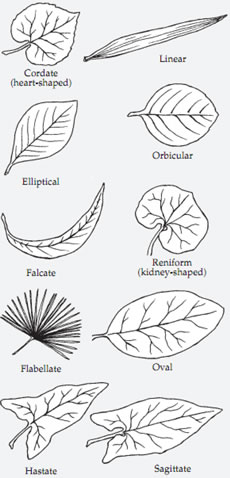 |
| Leaf shapes |
To assess the shape of a leaf, one examines the outline formed by the apex, margin, and base of the leaf or leaflet. If the leaf has teeth or lobes along its margin, one imagines a smooth curve interconnecting the tips of the teeth or lobes to assess the overall shape.
The shapes of compound leaves can likewise be assessed by imagining a smooth curve connecting the tips of the leaflets that form the compound leaf blade. The terminology below is used to describe the shape of laminae of simple and compound leaves as well as the laminae of the leaflets of compound leaves.
Elongated Leaves
Linear leaves have a long and very narrow leaf shape, with sides that are almost parallel with one another and are usually more than four times longer than broad. Oblong leaves have a rectangular leaf blade two to four times longer than it is wide, with sides that are almost parallel to each other.
Ensiform leaves resemble the shape of a broad sword. Ligulate leaves are straplike, resembling a tongue. Falcate leaves are elongated and recurved, resembling the shape of a sickle blade.
  |
Lanceolate leaves have a lance-shaped leaf, with the widest part of the leaf near the base and the narrowest part near the apex. The prefix ob means that the shape is inverted or upside down. Thus, oblanceolate leaves have a lance-shaped leaf, with the widest part of the leaf near the apex and the narrowest part near the base.
Circular to Elliptical Leaves
Orbicular leaves have a more or less circular leaf shape in which the width and length of the lamina are equal, or nearly so. Elliptical leaves have a shape that looks like an ellipse, twice as long as broad, with the widest part of the leaf near the middle. Oval leaves are broadly elliptical, with the blade width being more than half the length and the widest part of the leaf near the middle.
Oval leaves are wider than elliptical leaves of the same length. Ovate leaves are egg-shaped, with the widest part of the leaf below the middle toward the base, while obovate leaves are egg-shaped, with the widest part of the leaf above the middle toward the apex.
Other Shapes
Reniform leaves have a shape like a kidney. Cordate leaves are shaped like a valentine or heart, with the lobes of the valentine at the base of the leaf and the pointed portion at the apex.
Obcordate leaves are also valentine-shaped, but the lobes are at the apex, and the basal lamina tapers into the petiole. Sagittate leaves have a shape like an arrowhead. Hastate leaves are also shaped like an arrowhead, but the basal lobes diverge or extend away from the midrib, giving an outline that resembles a halberd.
Rhombic leaves have a more or less diamond shape, with straight margins and with the widest part of the leaf lamina near the middle. Spatulate leaves have a spoon-shaped or spatula-shaped leaf where the lamina is widest near the rounded apex.
Flabellate leaves are fan-shaped or broadly wedge-shaped, with the broadest part of the lamina at the apex. Deltoid leaves are delta-shaped, resembling an equiangular triangle. Often the sides of the deltoid leaves are slightly curved toward the apex.
Conifer Leaf Shapes
Needlelike, or acicular, leaves have a long and very narrow leaf shape, with sides that are almost parallel to each other and are usually more than ten times longer than broad. Acicular leaves are often borne on short lateral branches called fascicles. The number of acicular leaves per fascicle is constant within a species.
Linear leaves have a long, narrow leaf shape, with sides that are almost parallel with each other and usually are more than four times longer than broad. Linear leaves can be flat, triangular, or square in cross section. They may also exhibit a distinct twist along their vertical axes.
Subulate leaves are short, narrow, flat, stiff, awl-shaped leaves that taper to a sharp point. Scale leaves are small, inconspicuous leaves that are typically appressed tightly to the stem and have overlapping margins.
Scale leaves may or may not be photosynthetic (green). Decurrent leaves have an extension of tissue running down the stem be low the point of junction of the leaf, with a stem that forms awing or ridge of tissue.
Some species have leaves that are borne on a semiwoody peg that extends away from the twig surface. These pegs do not abscise with leaves and remain visible on the twig for many years after leaf abscission.